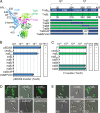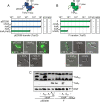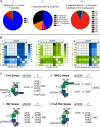Chimeric systems composed of swapped Tra subunits between distantly-related F plasmids reveal striking plasticity among type IV secretion machines
- PMID: 38437248
- PMCID: PMC10939261
- DOI: 10.1371/journal.pgen.1011088
Chimeric systems composed of swapped Tra subunits between distantly-related F plasmids reveal striking plasticity among type IV secretion machines
Abstract
Bacterial type IV secretion systems (T4SSs) are a versatile family of macromolecular translocators, collectively able to recruit diverse DNA and protein substrates and deliver them to a wide range of cell types. Presently, there is little understanding of how T4SSs recognize substrate repertoires and form productive contacts with specific target cells. Although T4SSs are composed of a number of conserved subunits and adopt certain conserved structural features, they also display considerable compositional and structural diversity. Here, we explored the structural bases underlying the functional versatility of T4SSs through systematic deletion and subunit swapping between two conjugation systems encoded by the distantly-related IncF plasmids, pED208 and F. We identified several regions of intrinsic flexibility among the encoded T4SSs, as evidenced by partial or complete functionality of chimeric machines. Swapping of VirD4-like TraD type IV coupling proteins (T4CPs) yielded functional chimeras, indicative of relaxed specificity at the substrate-TraD and TraD-T4SS interfaces. Through mutational analyses, we further delineated domains of the TraD T4CPs contributing to recruitment of cognate vs heterologous DNA substrates. Remarkably, swaps of components comprising the outer membrane core complexes, a few F-specific subunits, or the TraA pilins supported DNA transfer in the absence of detectable pilus production. Among sequenced enterobacterial species in the NCBI database, we identified many strains that harbor two or more F-like plasmids and many F plasmids lacking one or more T4SS components required for self-transfer. We confirmed that host cells carrying co-resident, non-selftransmissible variants of pED208 and F elaborate chimeric T4SSs, as evidenced by transmission of both plasmids. We propose that T4SS plasticity enables the facile assembly of functional chimeras, and this intrinsic flexibility at the structural level can account for functional diversification of this superfamily over evolutionary time and, on a more immediate time-scale, to proliferation of transfer-defective MGEs in nature.
Copyright: © 2024 Kishida et al. This is an open access article distributed under the terms of the Creative Commons Attribution License, which permits unrestricted use, distribution, and reproduction in any medium, provided the original author and source are credited.
Conflict of interest statement
The authors have declared that no competing interests exist.
Figures







Update of
-
Chimeric systems composed of swapped Tra subunits between distantly-related F plasmids reveal striking plasticity among type IV secretion machines.bioRxiv [Preprint]. 2023 Dec 6:2023.12.05.570194. doi: 10.1101/2023.12.05.570194. bioRxiv. 2023. Update in: PLoS Genet. 2024 Mar 4;20(3):e1011088. doi: 10.1371/journal.pgen.1011088. PMID: 38106057 Free PMC article. Updated. Preprint.
Similar articles
-
Chimeric systems composed of swapped Tra subunits between distantly-related F plasmids reveal striking plasticity among type IV secretion machines.bioRxiv [Preprint]. 2023 Dec 6:2023.12.05.570194. doi: 10.1101/2023.12.05.570194. bioRxiv. 2023. Update in: PLoS Genet. 2024 Mar 4;20(3):e1011088. doi: 10.1371/journal.pgen.1011088. PMID: 38106057 Free PMC article. Updated. Preprint.
-
Protein Transfer through an F Plasmid-Encoded Type IV Secretion System Suppresses the Mating-Induced SOS Response.mBio. 2021 Aug 31;12(4):e0162921. doi: 10.1128/mBio.01629-21. Epub 2021 Jul 13. mBio. 2021. PMID: 34253063 Free PMC article.
-
IncFV plasmid pED208: Sequence analysis and evidence for translocation of maintenance/leading region proteins through diverse type IV secretion systems.Plasmid. 2022 Sep-Nov;123-124:102652. doi: 10.1016/j.plasmid.2022.102652. Epub 2022 Oct 11. Plasmid. 2022. PMID: 36228885 Free PMC article.
-
The Agrobacterium VirB/VirD4 T4SS: Mechanism and Architecture Defined Through In Vivo Mutagenesis and Chimeric Systems.Curr Top Microbiol Immunol. 2018;418:233-260. doi: 10.1007/82_2018_94. Curr Top Microbiol Immunol. 2018. PMID: 29808338 Free PMC article. Review.
-
Biological and Structural Diversity of Type IV Secretion Systems.Microbiol Spectr. 2019 Mar;7(2):10.1128/microbiolspec.psib-0012-2018. doi: 10.1128/microbiolspec.PSIB-0012-2018. Microbiol Spectr. 2019. PMID: 30953428 Free PMC article. Review.
Cited by
-
Subdomains of the Helicobacter pylori Cag T4SS outer membrane core complex exhibit structural independence.Life Sci Alliance. 2024 Apr 17;7(6):e202302560. doi: 10.26508/lsa.202302560. Print 2024 Jun. Life Sci Alliance. 2024. PMID: 38631913 Free PMC article.
-
Conjugative delivery of toxin genes ccdB and kil confers synergistic killing of bacterial recipients.J Bacteriol. 2025 Jul 24;207(7):e0016825. doi: 10.1128/jb.00168-25. Epub 2025 Jul 3. J Bacteriol. 2025. PMID: 40608358 Free PMC article.
References
MeSH terms
Substances
Grants and funding
LinkOut - more resources
Full Text Sources

